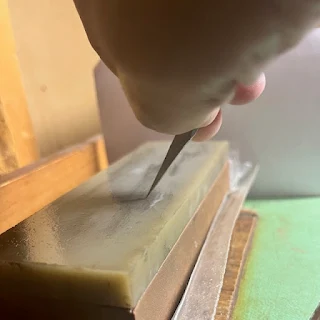These engraving blades are just phenomenal in their basic uses.
They must never be taken as a casual stone setting implement. They are one of the most delicate metal-cutting implements in our vast inventory.
The two blades you see here are the new, untouched blades. The bottom blade has been shaped on a bench grinder. This bottom blade is now ready to be used extensively, and under normal cutting procedures, one blade will & can last for many months.
If the oil is minimal, there could be slight overheating at the tip of the blade.
Every blade must have the same angle on every metal-cutting tip.
Even if the FLAT graver blade is ready for metal shaping, the angle must be at a 45-degree angle.
The bottom of every FLAT blade must have a highly polished surface.
How is this blade being given such a wonderful surface? The first step is to make the bottom of the FLAT surface as bright as possible.
I use a basic technique to achieve this high level of brilliance. I will rub the bottom of the blade by using a #1,200 grit polishing paper
To REVIEW!
Before any 'paper rubbing' has started, the polishing paper must be impregnated with a soft pencil core. This delicate process will make the #1,200 grit paper seem like it's now equivalent to at least #1,600 =>#1,800 grit. Interesting technique?
You don't need a thick-faced tip of the FLAT graver. This thickness is so unnecessary, and it prevents much wasted metal cutting.
Keep your oil stone well lubricated, as this oil acts as a lubricant and prevents any shards of graver metal from getting embedded into the oil stone.
When you are using the FLAT graver for the very first time, it might seem like a great idea to clean the bottom of the underneath surface on a fine oil stone.
It is important to initiate and maintain a flat & highly polished surface before any metal shaping & cutting has started.
I always keep my graver at a 90-degree angle, as I want all of the graver contacts equally touching the stone. Then gently lean the graver back to the desired 45-degree angle. Never assume the metal is being 'touched' to the stone.
No matter what you do...KEEP ALL OF YOUR BLADES WELL LUBRICATED!!! (Flood the oil surface with oil). Oil is cheap, and an oil stone needs much gentle care.

%20(1).jpg)
.jpg)
.jpg)
.jpg)
.jpg)
.jpg)
.jpg)
.jpg)





No comments:
Post a Comment